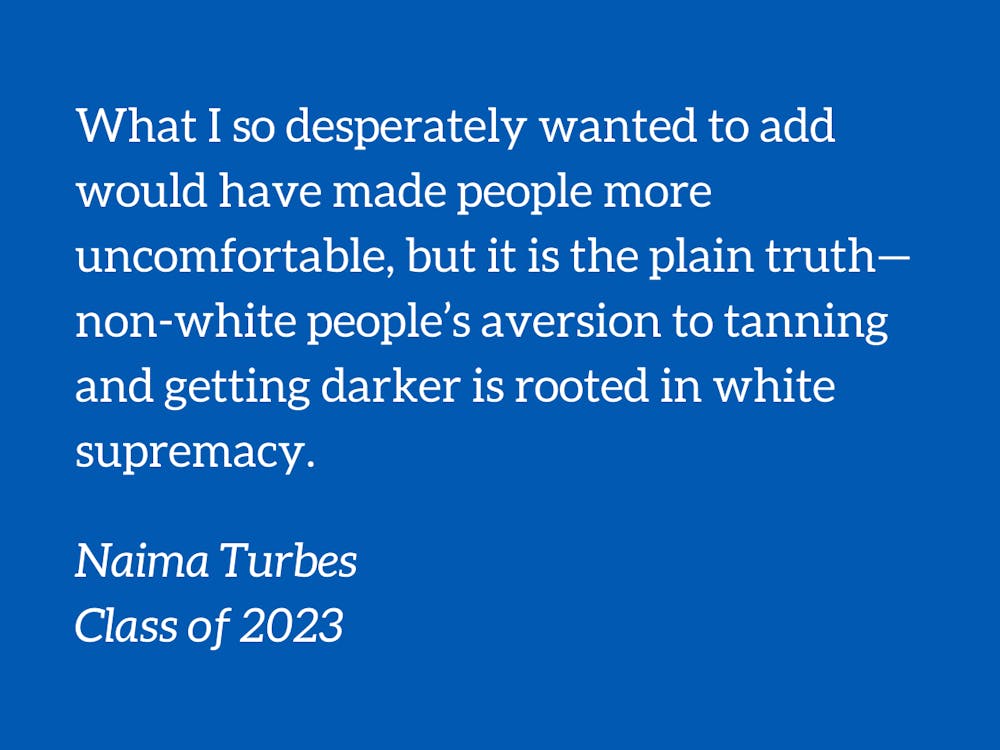This past week, I took cross country roster pictures with the most horrid short tan lines. Don’t go looking for the pictures, I made sure not to post them anywhere. But the whole exercise of suiting up in our underwear-like uniform and comparing the effects of hundreds of sunny summer miles sat with me for a bit. For those of color, tanning and conversations around tanning are not as straightforward as just turning a couple of shades darker depending on the season—with it comes a deep history of colorism and white supremacy.
I’ll admit I think about skin color at least twice a day as the only black member of Duke’s cross-country team. No one can deny I’m noticeably darker than the rest. And I am proud of it, I love the melanin in my skin. I think black and brown skin has a beautiful glow in the sun, and I love summers sitting in the sun in Atlanta with my brother. But my own comfort with my skin doesn’t make conversations around tanning and skin color easier.
The topic of tanning came up in both of my summer “study abroad” projects. I participated in the Duke Kenya WISER and the ACE in Vietnam summer programs (they were both online on Zoom…but we don’t have to talk about that right now). At least for the couple of hours on Zoom each day, it felt like I was in Vietnam or Kenya and not at home at my eroded 8th-grade desk. I remember vividly when one of the program directors brought up the “culture of tanning in America”. We all chatted about how tanning was not popular in Vietnam, where people more often wanted to remain as fair-skinned as possible. I am pretty sure I visibly cringed. So much so that one of my fellow Vietnamese coaches chatted me, asking why I was upset. Rather than respond via chat, I immediately unmuted, feeling passionate about drawing attention to the fact that “tanning culture” in the United States is specific to white people.
For the most part, black people don’t sit around tanning. I am in no way trying to speak for black people in America, but I would be astounded seeing a black person in a tanning booth. I said this much honestly in our Zoom discussion. Then the whole room got quiet, and we didn’t spend much more time on tanning culture after that.
What I so desperately wanted to add would have made people more uncomfortable, but it is the plain truth—non-white people’s aversion to tanning and getting darker is rooted in white supremacy. To be lighter is better. Unless you are clearly of European descent, the next best thing is to look like you might be white. This is a product of colonialism, violence and clear power indifferences, not just a mark of “different cultures”. Why do we forget that?
The next morning I woke up to teach robotics to some of the Kenyan girls over Zoom. When we finished the lesson for the day, I brought up tanning and skin color. For girls so intelligent and confident in their studies, I was surprised to see them a little bashful about the topic. Skin color felt a little off limits. It meant grappling with the fact that many of them were different shades of brown and had been taught by their families or in common culture that lighter is better. The ninth-grade girls understood tanning and skin color better than my Duke peers.
I would argue we should all be a little more sensitive when talking about tanning. As much as I wish a conversation about changing colors in the sun was an easy one, it is not for many people of color.
In short, tanning is complicated. Let’s treat it as such.
Naima Turbes is a Trinity junior and a Managing Editor of the Opinion section. Her column runs alternate Thursdays.
Get The Chronicle straight to your inbox
Signup for our weekly newsletter. Cancel at any time.

